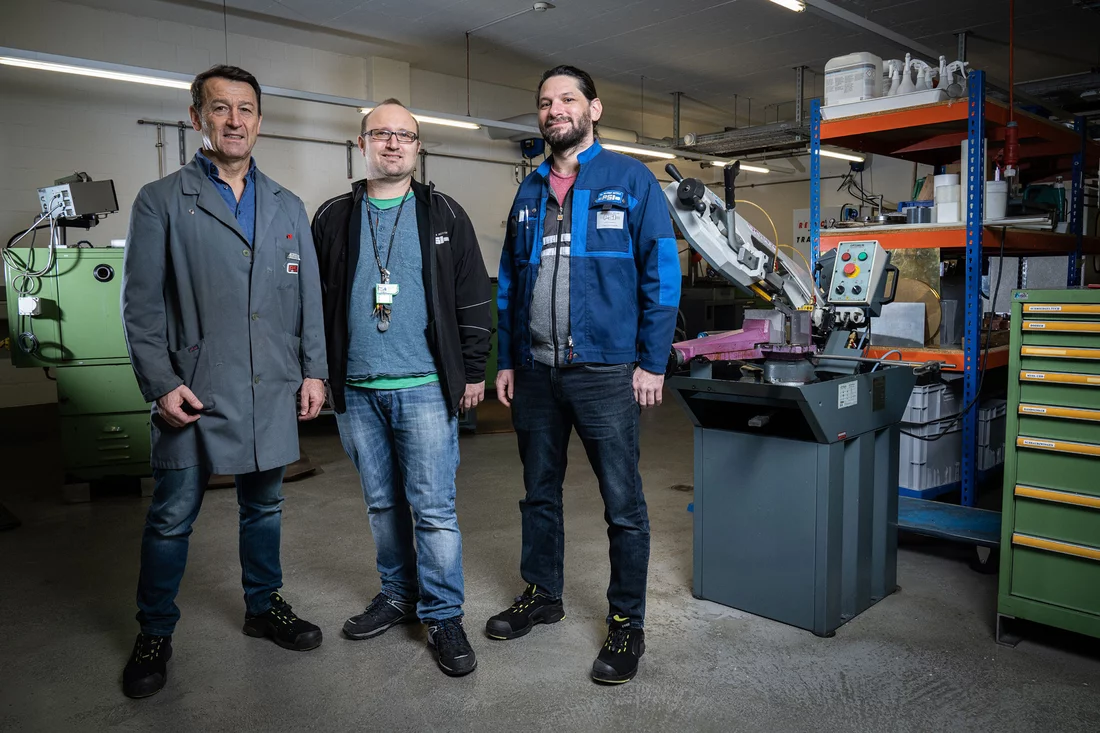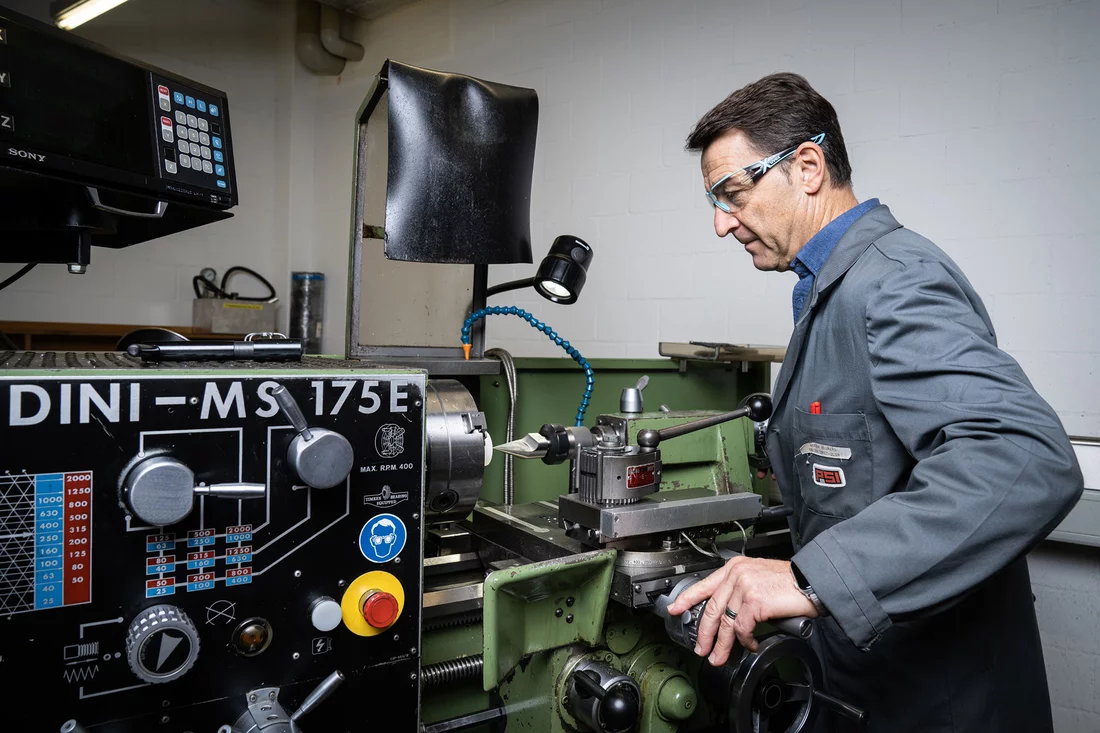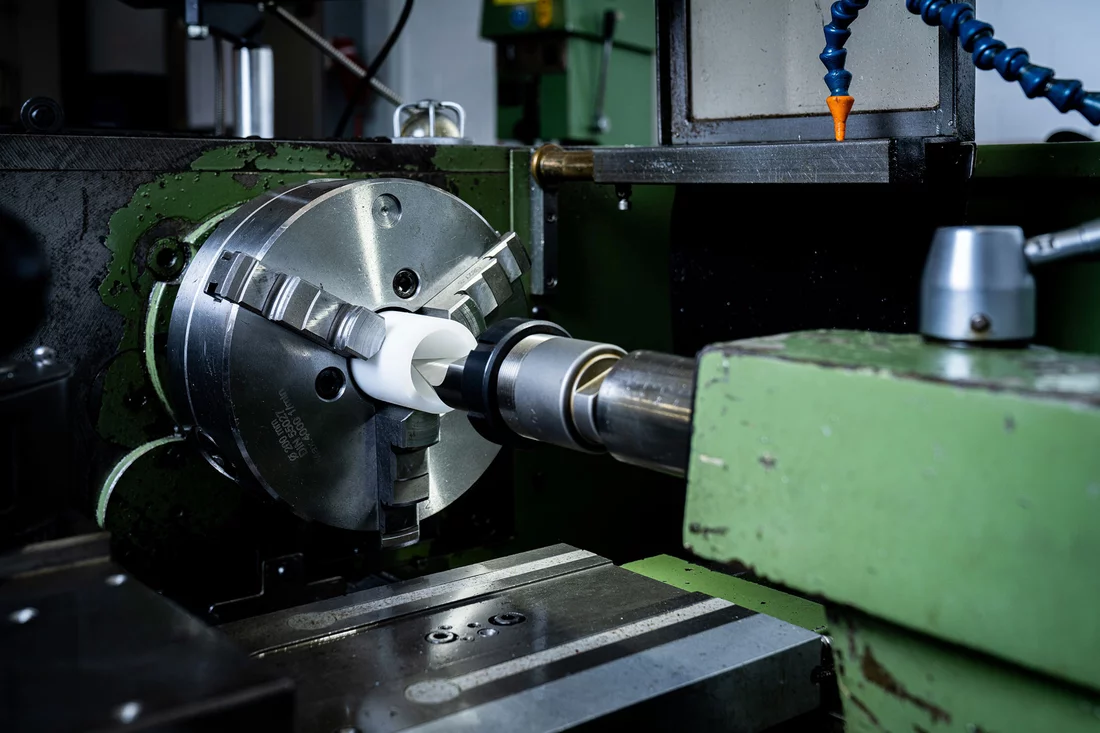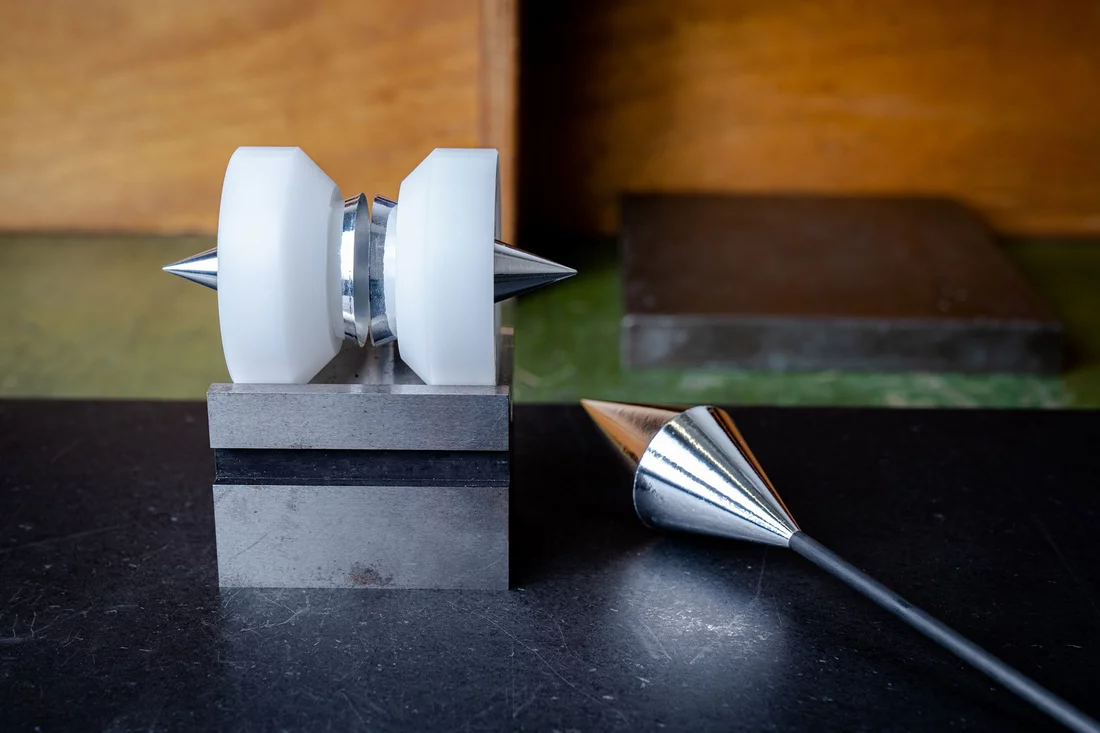Where do the many workpieces and components needed for complex scientific experiments at PSI actually come from? They certainly cannot be ordered on the Internet. Some are produced in PSI’s large workshops as part of long-term planning. Many essential components such as mountings for samples, heating structures or vacuum feedthroughs are also produced more or less on demand by technical staff such as those working in PSI’s own dedicated small workshop: Kleinwerkstatt Ost.
Behind the double door in the basement of the OLHB laboratory building lies the dream facility of all DIY fans: the extremely well-equipped workshop Kleinwerkstatt Ost, housing workbenches, machines and cabinets generously stocked with materials.
"In our workshop we have access to tools that simply don’t exist in a normal laboratory," says Andrés Laso, a technician with the PSI research division Energy and the Environment. Laso opens the drawers of the cabinets to display an impressive selection of screw taps, turning tools and milling cutters. Alongside that: a small arsenal of machine parts such as screws, nuts and gaskets. The shelves, in turn, are stacked with metal rods, plates and blocks of all shapes and sizes, as well as glue guns, soldering irons, screw clamps and much more besides.
Laso and his colleagues are especially proud of the machine tools set up in the room for milling, drilling, sawing or grinding metal, plastic or other materials. "We use these machines to produce prototypes for components, giving us the ability to test something very quickly to check whether it is viable," explains Laso, a highly skilled mechanic used to working in multiple disciplines.
Many machines operate conventionally – manually, in other words, rather than computer controlled. "These machines are our favourites, as they are far better suited to improvised work and modifying existing components," says Laso. "They have multiple uses and are one of the great strengths of such user-oriented workshops". But there is also a computer-controlled milling machine to make parts with more complex shapes.
'An incredibly varied job'
Research at PSI is not only carried out in high-tech chemistry and biology labs, along with futuristic large research facilities, but also in more conventional workshops such as Kleinwerkstatt Ost. Before many scientific experiments can even get started, the complex apparatus required has to be assembled. Researchers need customised parts for their experiments that have to perform a very specific function – and this is where the workshop technicians play a key role.
"The scientist describes the problem to me and explains what function the experiment or workpiece has to perform," says Dominik Herrmann, a technician with the research division Nuclear Energy and Safety. "I then think about how best to make the necessary component". Hermann and his colleagues work in the background to make sure many experiments are actually possible at PSI.
In the 1990s Andrés Laso and Dominik Herrmann both completed their training as polytechnicians at PSI. Five years ago they returned to PSI to work as technicians in what they like to describe as an “incredibly varied, all-round job”.
Making something quickly
More than twenty technicians from PSI’s five different research divisions come to Kleinwerkstatt Ost to make the equipment needed for experiments. "Spontaneity is required," Laso stresses. "We often make a decision in the morning about something we want to try, and in the afternoon I’ve already made the part, so it’s ready for use in the first batch of tests."
After initial testing, Laso then makes further improvements to the part if necessary – all of which can be done quickly thanks to the workshop’s close proximity to other research facilities on the campus. His work occasionally involves only minimal adjustments, such as drilling a few extra holes. "Sometimes, however, more complex structures are involved that require several days’ work."
Rapid adjustment of flexible components is particularly important at a research institute such as PSI, Dominik Herrmann adds: "The time slots booked for performing measurements on the beam line are fixed, so the required part has to be ready by then". This spontaneous approach of the express workshop is completely different from workshops operating on a contract basis. These are obviously important, as they make up the bulk of components required at PSI. Here, employees produce components based on design drawings, but with longer-term planning. The contract workshop offers many more possibilities than the small workshop.
Challenges overcome
Laso and Herrmann proudly present what they call their “showpieces” – custom-built parts in which they have invested a huge amount of time, effort and creativity. They include a measuring cell made of plastic and ceramic that is resistant to high temperatures, which Herrmann developed and built as part of his doctoral research. "The dimensions were chosen so that the measuring cell on the SINQ spallation source and in our measuring lab fits into the relevant detector mountings. This was important, to ensure a measurement is possible immediately after the sample is irradiated."
Andrés Laso also made a sample mounting for the vacuum chamber, which can be used to study the chemistry at the phase transition between solids and gases. The sample mounting is designed so that X-rays can be shot at the sample and it stays exactly in the centre. The sample mounting must be able to withstand low temperatures of up to minus seventy degrees Celsius, but it must also be possible to heat it from the inside. "The component is not quite perfect yet, but I’m still working on it," says Laso, laughing. Quite the perfectionist.
Muon stopper
Andreas Hofer, a technician working in the Research with Neutrons and Muons division, has also been working on a component for a long time – one that is destined for the planned Mu3e Experiment. This ambitious particle physics experiment investigates the decay of a specific particle, a muon, into three other particles: two positrons and one electron. According to the Standard Model of particle physics, this decay is highly unlikely – but if measured at PSI, it would highlight the difference between our current view of the world and reality. "We are currently in the process of setting up the experiment, which will then run for many years," explains Andreas Hofer.
The Mu3e Experiment requires a structure which slows down the muons as they hit it. This consists of two aluminium-coated hollow cones with different wall thicknesses that meet at their base. "My colleagues and I were commissioned to make this part – which took us roughly six months," says Hofer. The cones consist of extremely thin foil that have to be evenly coated with aluminium.
After many attempts, and rejecting what initially seemed to be good approaches, one method turned out to be ideal: in the workshop, Andreas Hofer produced workpieces made of plastic with conical openings into which a foil coated with aluminium is inserted to give it the precise shape required. "If we didn’t have our small workshop, where we can use the machines spontaneously at any time, this would have been virtually impossible."
With their know-how and flexibility, the technicians in Kleinwerkstatt Ost provide valuable support for scientists, so that cutting-edge research is even possible. There are already plans to move the small workshop to bigger premises and position it as the official user workshop for the PSI East campus.
Text: Paul Scherrer Institute/Brigitte Osterath
Contact
Günther Wehrle
Head of Kleinwerkstatt Ost
Energy and Environment Research Division
Telephone: +41 56 310 54 16
E-mail: guenther.wehrle@psi.ch
Copyright
PSI provides image and/or video material free of charge for media coverage of the content of the above text. Use of this material for other purposes is not permitted. This also includes the transfer of the image and video material into databases as well as sale by third parties.




